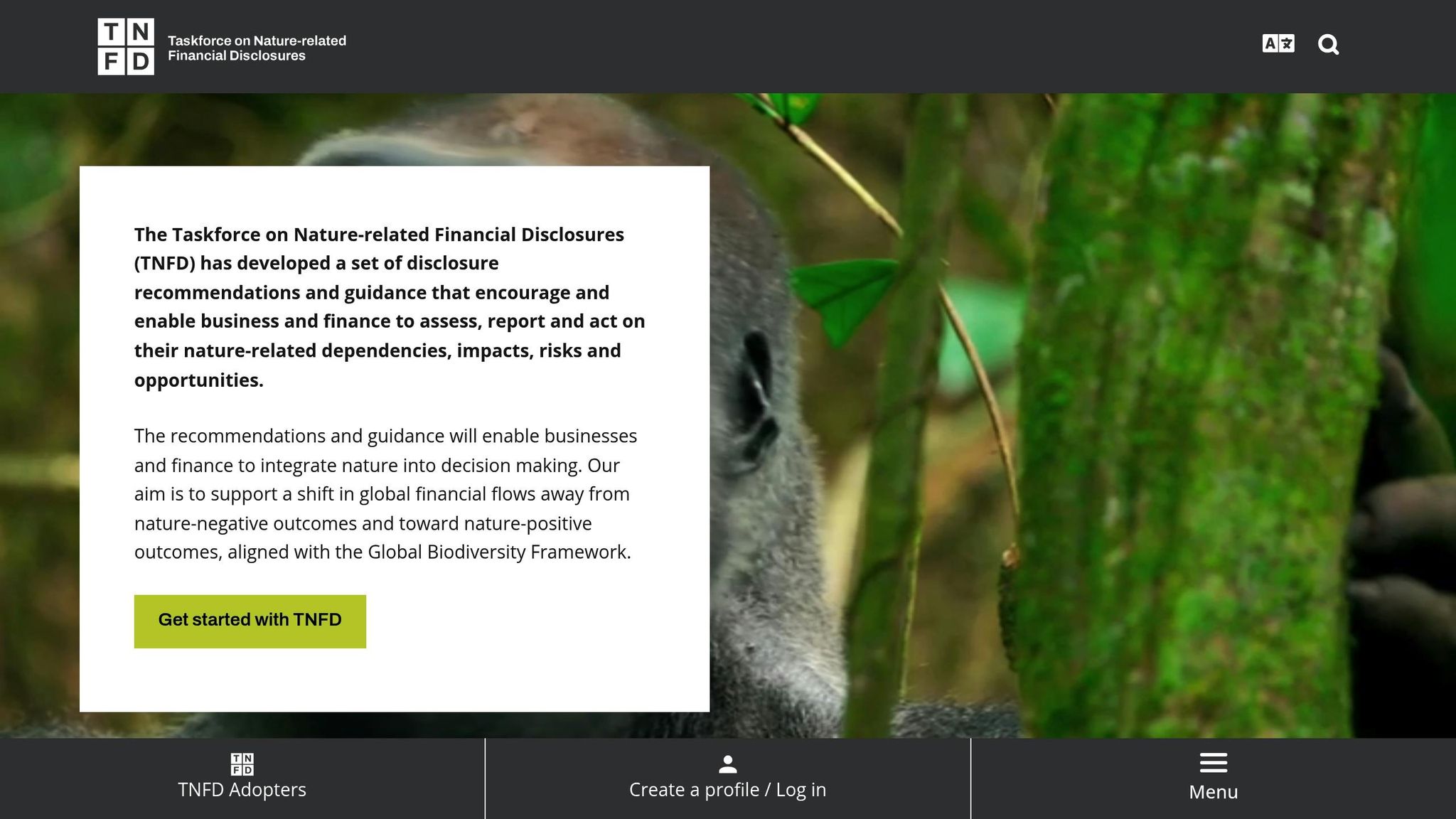Biodiversity Reporting: Strategic Guide to CSRD, TNFD & ESRS E4 Compliance
Biodiversity reporting has become essential for corporate sustainability. Why? Because...
By: Johannes Fiegenbaum on 8/2/25 9:23 AM

The Taskforce on Nature-related Financial Disclosures (TNFD) offers companies a voluntary framework to assess and disclose nature-related risks and opportunities. The goal is to integrate nature into business decisions and redirect capital flows toward nature-friendly projects. Why is this important? More than half of global GDP depends directly or indirectly on nature—and biodiversity loss represents a growing risk. According to the World Economic Forum, approximately $44 trillion of economic value generation—over half the world's total GDP—is moderately or highly dependent on nature and its services, underscoring the urgency for businesses to address these dependencies (WEF, 2020).
Key Points:
Conclusion: TNFD is more than just a reporting standard—it’s an opportunity to actively manage biodiversity risks and future-proof your business. Now is the right time to get started.

The TNFD framework is built on four central pillars: Governance, Strategy, Risk and Impact Management, and Metrics and Targets. These areas are designed to help companies better understand and manage nature-related risks and opportunities. TNFD builds on the recommendations of the Task Force on Climate-related Financial Disclosures (TCFD), expanding them to specifically address nature. This alignment ensures that organizations already familiar with TCFD can transition smoothly to TNFD, leveraging existing governance and reporting structures (CDSB, 2021).
The Governance pillar emphasizes that nature-related topics should be integrated into top-level decision-making. Boards and executive management are responsible for biodiversity issues. In the Strategy area, companies are expected to set clear objectives aligned with TNFD principles. Risk and Impact Management requires implementing processes to identify, assess, and minimize nature-related risks—this demands a deep understanding of the interactions between business activities and the environment. Finally, the Metrics and Targets pillar calls for the introduction of measurable indicators to monitor progress. Over 400 organizations worldwide have already adopted TNFD recommendations, reflecting a rapidly growing movement toward nature-positive business practices (TNFD Adopters).
These pillars highlight the importance of taking a holistic view of the relationship between business and nature.
The double materiality approach requires companies to consider both their impacts on nature (so-called impact materiality) and the effects of nature on their business (financial materiality). This approach is also reflected in the European Sustainability Reporting Standards (ESRS). The financial dimension is underscored by the fact that more than half of global GDP—around $44 trillion—is dependent on natural resources and ecosystem services. The European Commission notes that double materiality is central to the CSRD and ESRS, ensuring that both environmental and financial perspectives are addressed (European Commission).
Professor Nicola Ranger of the London School of Economics sums up the connection vividly:
"Nature is more than birds, bees, and butterflies; it’s about the fundamental ecosystem services on which our prosperity depends—water, food systems, raw materials. This new research synthesizes findings from hundreds of studies and clearly shows that nature loss is a material financial risk for the economy and the financial system. This is a risk that every prudent decision-maker should be aware of when making investment decisions."
The TNFD recommendations make it clear that nature-related risks and opportunities can have financial impacts on companies—whether through changes in revenues, expenses, investments, or access to capital. A 2022 KPMG survey found that 75% of global CEOs recognize biodiversity loss as a material risk to their business, highlighting growing awareness in the corporate sector (KPMG CEO Outlook).
Beyond the financial dimension, TNFD also places special emphasis on the importance of location.
The TNFD framework is based on seven guiding principles that ensure a scientifically sound approach, consideration of nature-related risks, and a global perspective. A central component is the LEAP Process (Locate, Evaluate, Assess, Prepare), which helps companies systematically identify and evaluate nature-related issues.
Location-based analysis is crucial here. It enables a better understanding of nature-related dependencies, impacts, risks, and opportunities. TNFD highlights that certain areas—so-called "sensitive locations"—are particularly important for biodiversity and ecosystem services. In practice, this approach has proven effective: companies like IndusInd Bank and Tesco have used the LEAP process to analyze their supply chains and assess their biodiversity footprints (TNFD Case Studies). For example, Tesco mapped its agricultural supply chain using geospatial data to identify biodiversity hotspots and prioritize interventions, demonstrating the practical value of location-based assessments.
Another key aspect of the TNFD guiding principles is the inclusion of indigenous peoples, local communities, and other stakeholders. By incorporating local knowledge and regional perspectives, nature-related topics are assessed comprehensively and respectfully. The framework encourages stakeholder engagement as a means to achieve more robust and equitable outcomes (TNFD Guiding Principles).
Based on the core principles of TNFD, here’s how you can embed them into your ESG strategy.
Identifying nature-related risks requires more than traditional environmental assessments. The LEAP Process (Locate, Evaluate, Assess, Prepare) provides a structured approach. With it, you can map locations with nature interactions, assess dependencies and impacts, quantify risks and opportunities, and prepare results for strategic decisions.
Why is this so important? Over half of global GDP—almost $44 trillion—directly depends on nature and its services. This dual perspective, highlighting both risks and opportunities, is crucial. For example, the World Bank estimates that the collapse of ecosystem services could result in a global GDP decline of $2.7 trillion annually by 2030 (World Bank, 2021).
Another key to success: training. Build targeted knowledge across all relevant departments to effectively anchor the TNFD framework. Companies such as Unilever have established cross-functional biodiversity working groups to ensure TNFD principles are embedded throughout the organization (Unilever TNFD Disclosure).
Once you’ve identified nature-related risks, use these insights to comply with German and European regulatory requirements. The Corporate Sustainability Reporting Directive (CSRD) and the European Sustainability Reporting Standards (ESRS) require specific disclosures on biodiversity and ecosystems. In particular, ESRS E4 emphasizes that such topics must be classified as material. The European Financial Reporting Advisory Group (EFRAG) has published guidance on integrating TNFD-aligned disclosures into ESRS reporting, making compliance more straightforward for German companies (EFRAG ESRS).
The LEAP approach is explicitly recommended by the ESRS to assess environmental aspects beyond climate change. In addition, the TNFD approach supports the concept of double materiality, which is also required by the ESRS.
Inka Gnittke, Deputy Director General of the Nature Conservation Department at the German Federal Ministry for the Environment, explains:
"The TNFD is crucial to ensure that nature is integrated as an important economic factor and not treated as an externality... TNFD equips companies with the tools they need to assess ecosystem services as critical economic components."
In practice, this means: Review your current and future disclosure obligations regarding nature-related topics.
Integrating TNFD into your ESG reporting can be seamless, as the framework is compatible with established standards such as TCFD, GRI, and the ISSB standards. Of the 14 TNFD disclosure recommendations, 11 are directly derived from the TCFD framework. This compatibility streamlines reporting and minimizes duplication of effort (IFRS Foundation).
You can expand your existing reporting frameworks to include nature-related aspects and specifically look for “quick wins”—measures that simultaneously meet TCFD, TNFD, and ISSB requirements. Existing data, such as water consumption or raw material usage, can often be directly used for TNFD disclosure.
Abyd Karmali, Managing Director of Environmental Business Advisory at Bank of America, emphasizes:
"Disclosure must go beyond compliance and actively drive the transition to a nature-positive economy... TNFD’s holistic framework, which is already stimulating a reallocation of capital toward nature-based investments, is not just a passing trend but part of a larger, secular transformation in the market."
Leverage digital tools and AI solutions to reduce the complexity of sustainability reporting. The growing acceptance of the TNFD framework is evident: in just 14 months, over 500 organizations have adopted it. Interestingly, organizations are 2.3 times more likely to disclose nature-related topics if financial institutions demand it (TNFD Adopters).
After integrating TNFD into your ESG strategy, you’ll need concrete tools and a clear plan for implementation. From specialized data platforms to AI-powered analysis tools, there are numerous resources to help you get started. Below, we present some key tools and a practical step-by-step implementation guide.
The TNFD Tools Catalogue is regularly updated and offers a wide range of nature-related data tools. You can filter by LEAP phases, industry-specific applications, and other features. However, TNFD does not verify the quality of the listed tools itself—being listed in the catalogue is not an endorsement. Therefore, it’s important to review the tools independently.
Some examples from the catalogue include:
Implementing TNFD requires a structured approach based on the framework’s four pillars: governance, strategy, risk and impact management, and metrics and targets.
These steps help you strategically expand your existing sustainability initiatives. The World Business Council for Sustainable Development (WBCSD) provides additional sector-specific guidance for TNFD implementation, which can further support companies in their transition (WBCSD TNFD Resources).
Your current sustainability program provides a solid foundation for integrating TNFD. The framework helps companies better understand the impact of nature on financial performance and integrate nature-related risks and opportunities into strategic planning, risk management, and asset allocation.
In addition to the regulatory requirements of the EU Taxonomy Regulation, which defines criteria for environmentally sustainable activities—such as biodiversity targets—there are further examples: The Dutch Central Bank (DNB) found that 36% of Dutch financial institutions’ investments are highly dependent on ecosystem services. This illustrates how closely financial risks are linked to biodiversity (DNB, 2019).
The Science Based Targets Network (SBTN) provides guidelines for setting science-based targets to protect nature. Countries like the United Kingdom are already considering making TNFD-aligned disclosures mandatory (UK Government, 2023). It’s important to make optimal use of existing data sources, as much of the information collected for other sustainability standards can also be used for TNFD disclosures. This significantly reduces additional effort.
Integrating TNFD recommendations into your ESG strategy can help German companies not only meet regulatory requirements but also gain real competitive advantages. While many companies are still finding their way, those who act early have the chance to position themselves strategically and actively shape future developments.
Better risk management and access to capital are at the heart of TNFD’s advantages. Bettina Hoffmann, Parliamentary State Secretary at the BMUV, puts it succinctly:
“It is essential to integrate the valuable services of ecosystems into financial and business models. This not only reduces risks but also enables new competitive advantages. TNFD provides a practical, less bureaucratic toolkit for this purpose."
Capital flows toward nature-based investments are already increasing. Abyd Karmali, Managing Director of Environmental Business Advisory at Bank of America, explains:
“TNFD’s holistic framework, which is already stimulating a shift of capital toward nature-based investments, is not just a passing trend but part of a larger, secular transformation of the market."
Another benefit is enhanced reputation through transparency. Companies that openly share biodiversity information can build trust. Daniel Craig, TNFD Co-Chair, emphasizes:
“Nature risks are already implicitly embedded in balance sheets, portfolios, and investment decisions. Raising awareness of this and strategically managing nature-related factors is a crucial step toward long-term resilient business models."
Early involvement in TNFD gives you the opportunity to help shape future standards. Currently, there are only six TNFD users in Germany—compared to 11 in Switzerland, 23 in France, and 68 in the United Kingdom (as of December 2024). This shows the significant potential to position yourself as a pioneer. Regulatory developments further support this momentum. According to a 2024 PwC report, 83% of investors believe that companies disclosing nature-related risks will be better positioned for long-term growth (PwC, 2024).
The EU Corporate Sustainability Reporting Directive (CSRD) requires nature-related disclosures and is closely aligned with TNFD recommendations. David Craig, Co-Chair of TNFD, underscores:
“Voluntary adoption of the TNFD recommendations is now the best way to meet these evolving expectations and new regulatory requirements such as the CSRD."
Furthermore, TNFD recommendations support the implementation of Target 15 of the Global Biodiversity Framework (GBF). This enables companies to advance the integration of nature into their decision-making processes. Regulators may use this framework as a basis for further guidelines in the future. The United Nations Convention on Biological Diversity (CBD) highlights TNFD as a key tool for private sector engagement in achieving global biodiversity targets (CBD TNFD).
Alongside the benefits, practical implementation of TNFD also brings challenges that need to be addressed.
Implementing TNFD recommendations presents capacity challenges for many organizations. At the same time, new technologies such as artificial intelligence offer cost-effective ways—especially for small and medium-sized enterprises—to better understand the importance of nature for their business, often without the need for extensive in-house expertise. For instance, AI-driven tools can automate biodiversity data collection and risk assessment, reducing the burden on internal teams (Nature, 2023).
Maxim Vergeichik, Team Lead on Private Sector Engagement at the UNDP Nature Hub, explains:
“Artificial intelligence can help small and medium-sized enterprises take action on their dependencies and impacts on nature, as well as risks to their own business activities, cost-effectively and without excessive in-house expertise."
Over 400 organizations worldwide have already committed to TNFD—together representing a market capitalization of over $6 trillion. In addition, 25% of systemically important banks globally are TNFD adopters (TNFD Adopters).
Close collaboration between companies and governments is also recommended to better address challenges. The more than 220,000 downloads of TNFD guidance documents in the past 12 months show just how great the interest and willingness to implement already are.
With the TNFD framework, German companies can systematically manage nature-related risks while benefiting from increasing sustainable capital flows. The ideal time to start implementation is now.
The path to TNFD implementation is unique for every company, but TNFD provides a comprehensive “Getting Started” guide. This guide covers six key areas: the TNFD recommendations, additional guidance, the TNFD Forum, the Knowledge Hub, the Tools Catalogue, and registration of implementation intent. Especially in Germany, specific platforms and government funding make it easier to get started and provide additional support.
An important resource for German companies is the specially established German TNFD platform. It offers a valuable opportunity to advance nature-related financial reporting and act as a consulting group for TNFD. This platform complements global requirements while strengthening the local market. It supports companies through knowledge transfer, sharing of experiences, and methodological guidance for implementing TNFD recommendations.
The German government is also showing commitment by supporting the development of the TNFD framework and financially backing market integration (BMUV TNFD).
A good starting point is to use resources such as the TNFD Forum, the Knowledge Hub, and the Tools Catalogue. The TNFD Forum provides access to learning opportunities and networks, while the Knowledge Hub offers extensive materials for capacity building. The Tools Catalogue also provides practical instruments to help companies with implementation.
A crucial aspect is linking with existing ESG processes. Since all 14 TNFD disclosures are included in the European Sustainability Reporting Standards (ESRS) and TNFD supports the ESRS double materiality approach, companies can use their ongoing CSRD preparations as a solid foundation. In addition to these synergies, external consulting can also make a significant difference.
Specialized consulting firms such as Fiegenbaum Solutions offer targeted support for integrating TNFD into existing ESG strategies—from materiality analysis to optimizing reports. This expertise makes getting started much easier.
Emmanuel Macron aptly sums up the importance of this approach:
“Integrating biodiversity into all sectors ensures the transition to sustainable financial flows.”
For German companies, this means: Take action now—not only to meet regulatory requirements, but also to help shape a sustainable future.
The TNFD framework provides companies with valuable guidance to identify biodiversity risks early and address them in a targeted way. This not only helps meet regulatory requirements—it also opens up opportunities to strengthen competitiveness and establish sustainable business practices.
A sensible entry point for applying the framework could include the following steps:
By integrating the TNFD framework, you lay the foundation for reducing long-term risks while unlocking new opportunities in sustainability. The TNFD Knowledge Hub offers practical guides and case studies to help you get started (TNFD Knowledge Hub).
The LEAP process in the TNFD framework consists of four clearly defined steps: Locate, Evaluate, Assess, and Prepare. The goal is to systematically identify nature-related risks and opportunities and integrate these insights into your corporate strategy.
With the LEAP process, companies can better understand their dependencies on natural resources and their impacts, assess risks in a well-founded way, and develop targeted actions. This not only improves sustainability but also increases the company’s resilience to future challenges. By integrating this process into your ESG strategy, you create a reliable foundation for strategically and effectively managing biodiversity aspects. For detailed guidance, see the official TNFD LEAP guidance (TNFD LEAP Guidance).
Implementing TNFD recommendations brings several challenges for companies. These include integrating nature-related risks into existing processes, collecting and analyzing relevant data, and adapting strategy to new disclosure requirements. These tasks require not only time and resources but also careful planning.
An effective first step is a gap analysis to clearly identify weaknesses and areas for improvement. Such analyses help derive targeted actions. At the same time, training and workshops can strengthen employee understanding and competence—a key building block for successful implementation. Engaging with experts and using specialized tools also help ensure data quality and streamline processes.
It’s important to proceed step by step, involving all relevant departments. This way, TNFD standards can be seamlessly integrated into your corporate strategy, unlocking long-term benefits for your company. For additional support, the TNFD Forum and Knowledge Hub offer peer learning and expert advice (TNFD Forum).

ESG & sustainability consultant specializing in CSRD, VSME, and climate risk analysis. 300+ projects for companies like Commerzbank, UBS, and Allianz.
More aboutExecutive...
The TNFD framework provides companies with a clear roadmap to understand and transparently report...